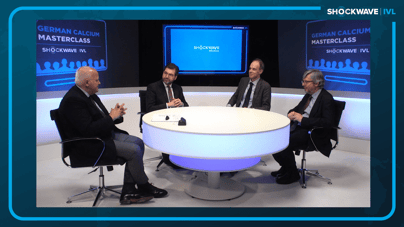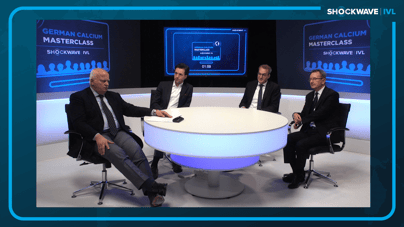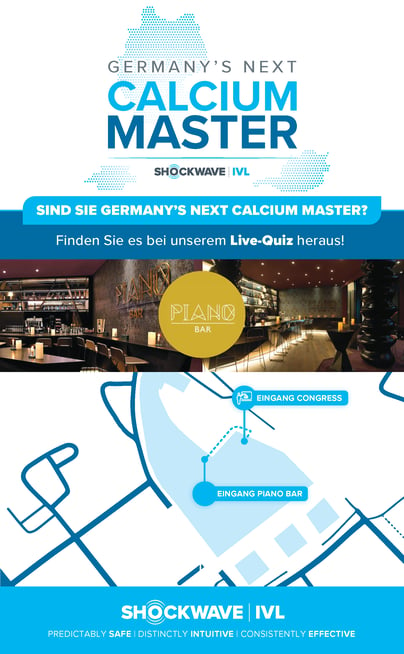German Calcium Masterclass 2023
Kalzium ist nicht nur oberflächlich ... manchmal muss man in die Tiefe!
Nach dem großen Erfolg der englischsprachigen Calcium Masterclass Webinar-Reihe und auf vielfachen Wunsch haben wir unser interaktives Fortbildungsformat nun auch auf Deutsch produziert.
In den drei neuen Folgen der Calcium Masterclass befasst sich das hochkarätige Panel von Calcium Experten aus Deutschland, Österreich und der Schweiz mit den Herausforderungen des Koronarkalks. Unter anderem werden die Vermittlung eines besseren Verständnisses für die Risiken und Therapie-Möglichkeiten bei der Kalziummodifikation, die Analyse der Datenlage zur Intravaskulären Lithotripsie und die Frage, wie IVL die Gefäßvorbereitung verbessern kann, im Fokus stehen.
In der umfassenden Analyse von zwei spannenden Live-Fällen wird die Theorie der Intravaskulären Lithotripsie in der praktischen Anwendung diskutiert – Seien Sie ab 13. Sept. 2023 mit dabei!
Prof. Michaal Haude - Moderator der German Calcium Masterclass
HERAUSFORDERUNGEN DES KORONAREN KALKS UND DIE AUSWIRKUNGEN AUF PROZEDURALE UND KLINISCHE ERGEBNISSE

Nehmen Sie an diesem Webinar teil, wenn Sie:
- die Herausforderungen von koronarem Kalk und ihre Auswirkungen auf die PCI-Ergebnisse verstehen wollen
- den Wirkmechanismus der intravaskulären Lithotripsie bei verkalkten Läsionen kennenlernen möchten
- verstehen möchten, wie Komplikationen bei der Behandlung von Koronarkalk minimiert werden können
am 13. Sept. 17:00 Uhr LIVE, anschließend on demand.
IVL IM KLINISCHEN ALLTAG & KALZIUM-ALGORITHMEN

Nehmen Sie an diesem Webinar teil, wenn Sie:
- die Rolle der intravaskulären Lithotripsie im Behandlungs-Algorithmus verkalkter Stenosen kennenlernen möchten.
- die neuesten Daten zur intravaskulären Lithotripsie aus dem DISRUPT-CAD-Datenpool kennenlernen möchten.
- einen komplexen Fall einer linken Hauptstemm-Bifurkation verfolgen möchten.
am 27. Sept. 17:00 Uhr LIVE, anschließend on demand.
DIE MÖGLICHKEITEN DER IVL UND WANN EINE THERAPIE-KOMBINATION SINNVOLL IST

Nehmen Sie an diesem Webinar teil, wenn Sie
- anhand klinischer Best Practice Beispiele mehr über die Behandlung schwieriger kalzifizierter Läsionen lernen möchten
- die Wirksamkeit der IVL bei exzentrischen und nodulären Verkalkungen verstehen möchten
- erfahren möchten, wann es sinnvoll ist, die IVL zur Behandlung nicht passierbarer Läsionen zu kombinieren
am 18. Okt. 17:00 Uhr LIVE, anschließend on demand.
SIND SIE GERMANY'S NEXT CALCIUM MASTER?
Finden Sie es heraus bei unserem Live-Quiz am 06. Okt. 2023 um 19:00 Uhr in der Piano Bar des GOP-Varieté Theaters, Bonn (direkt neben dem World Conference Center).
Kämpfen Sie mit unserem Experten-Team um Dr. Luise Gaede, Dr. Stefan Harb, Dr. Christina Brinkmann und Dr. Milad Golabkesh um den Sieger-Titel Germany’s Next Calcium Master!
Weitere Informationen zur Location und dem Experten-Team finden Sie im Veranstaltungsflyer hinter dem Link im Bild.
Moderiert vom Master of Ceremony Erik Rafflenbeul.
Achtung: auf 50 Teilnehmer limitiert, deshalb möglichst früh vor Ort sein.
To keep up on the real-time Shockwave IVL activities, follow @ShockwaveIVL on Twitter!
Coronary IVL Important Safety Information
Please contact your local Shockwave representative for specific country availability and refer to the Shockwave C2 and Shockwave C2+ instructions for use containing important safety information.
In the United States: Rx only
Indications for Use—The Shockwave Intravascular Lithotripsy (IVL) System with the Shockwave C2 Coronary IVL Catheter is indicated for lithotripsy enabled, low-pressure balloon dilatation of severely calcified, stenotic de novo coronary arteries prior to stenting.
Contraindications—The Shockwave C2 Coronary IVL System is contraindicated for the following: This device is not intended for stent delivery. This device is not intended for use in carotid or cerebrovascular arteries.
Warnings— Use the IVL Generator in accordance with recommended settings as stated in the Operator’s Manual. The risk of a dissection or
perforation is increased in severely calcified lesions undergoing percutaneous treatment, including IVL. Appropriate provisional interventions should be readily available. Balloon loss of pressure was associated with a numerical increase in dissection which was not statistically significant and was not associated with MACE. Analysis indicates calcium length is a predictor of dissection and balloon loss of pressure. IVL generates mechanical pulses which may cause atrial or ventricular capture in bradycardic patients. In patients with implantable pacemakers and defibrillators, the asynchronous capture may interact with the sensing capabilities. Monitoring of the electrocardiographic rhythm and continuous arterial pressure during IVL treatment is required. In the event of clinically significant hemodynamic effects, temporarily cease delivery of IVL therapy.
Precautions— Only to be used by physicians trained in angiography and intravascular coronary procedures. Use only the recommended balloon
inflation medium. Hydrophilic coating to be wet only with normal saline or water and care must be taken with sharp objects to avoid damage to the hydrophilic coating. Appropriate anticoagulant therapy should be administered by the physician. Precaution should be taken when treating patients with previous stenting within 5mm of target lesion.
Potential adverse effects consistent with standard based cardiac interventions include– Abrupt vessel closure – Allergic reaction to contrast medium, anticoagulant and/or antithrombotic therapy-Aneurysm-Arrhythmia-Arteriovenous fistula-Bleeding complications-Cardiac tamponade or pericardial effusion-Cardiopulmonary arrest-Cerebrovascular accident (CVA)-Coronary artery/vessel occlusion, perforation, rupture or dissection-Coronary artery spasm-Death-Emboli (air, tissue, thrombus or atherosclerotic emboli)-Emergency or non-emergency coronary artery bypass surgery-Emergency or non-emergency percutaneous coronary intervention-Entry site complications-Fracture of the guide wire or failure/malfunction of any component of the device that may or may not lead to device embolism, dissection, serious injury or surgical intervention-Hematoma at the vascular access site(s)-Hemorrhage-Hypertension/Hypotension-Infection/sepsis/fever-Myocardial Infarction-Myocardial Ischemia or unstable angina-Pain-Peripheral Ischemia-Pseudoaneurysm-Renal failure/insufficiency-Restenosis of the treated coronary artery leading to revascularization-Shock/pulmonary edema-Slow flow, no reflow, or abrupt closure of coronary artery-Stroke-Thrombus-Vessel closure, abrupt-Vessel injury requiring surgical repair-Vessel dissection, perforation, rupture, or spasm.
Risks identified as related to the device and its use: Allergic/immunologic reaction to the catheter material(s) or coating-Device malfunction, failure, or balloon loss of pressure leading to device embolism, dissection, serious injury or surgical intervention-Atrial or ventricular extrasystole-Atrial or ventricular capture.
Prior to use, please reference the Instructions for Use for more information on warnings, precautions and adverse events.
https://shockwavemedical.com/IFU








